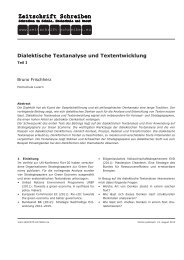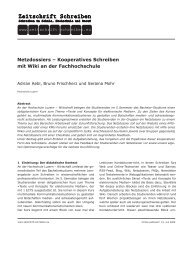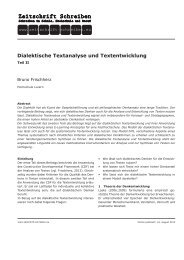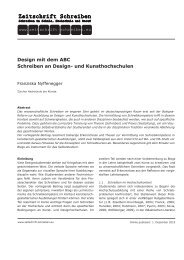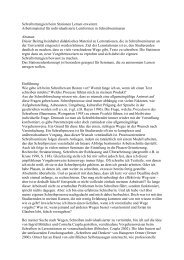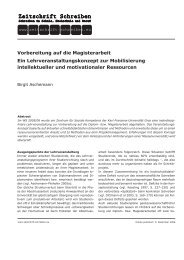Active Reading and the Teaching of Writing - Zeitschrift Schreiben
Active Reading and the Teaching of Writing - Zeitschrift Schreiben
Active Reading and the Teaching of Writing - Zeitschrift Schreiben
Create successful ePaper yourself
Turn your PDF publications into a flip-book with our unique Google optimized e-Paper software.
We can make a fundamental distinction between open<br />
questions <strong>and</strong> close ones. With «close questions» we<br />
mean questions whose answer is already known to<br />
<strong>the</strong> teacher or to <strong>the</strong> interviewer; <strong>the</strong>se questions are<br />
useful to monitor students’ ability to extract significant<br />
information from <strong>the</strong> text. Instead, with «open<br />
questions» we can monitor <strong>the</strong> ability to rise new<br />
problems, to propose original opinions <strong>and</strong> to analyze<br />
a text looking for pro<strong>of</strong>s to support a <strong>the</strong>sis.<br />
In order to highlight that knowledge can be reached<br />
toge<strong>the</strong>r thanks to collaborative work in <strong>the</strong> class, every<br />
student gets a text <strong>and</strong> proposes an open question.<br />
Every answer must be supported by a selection <strong>of</strong><br />
significant passages from <strong>the</strong> text.<br />
For example, we can propose to read <strong>the</strong> famous<br />
episode <strong>of</strong> Paolo <strong>and</strong> Francesca in Dante Alighieri’s<br />
Divine Comedy (Inferno, V, that means «fifth section<br />
<strong>of</strong> <strong>the</strong> Hell»). 22<br />
Some examples <strong>of</strong> close question are:<br />
– Who is Francesca?<br />
– How is lust punished in Dante’s opinion?<br />
Instead, some examples <strong>of</strong> open questions are:<br />
– Which are <strong>the</strong> most interesting elements <strong>of</strong> <strong>the</strong><br />
text to describe Dante’s attitude towards Paolo <strong>and</strong><br />
Francesca’s story?<br />
– Why does Dante faint so <strong>of</strong>ten in <strong>the</strong> first sections <strong>of</strong><br />
<strong>the</strong> Hell? 23<br />
Questions’ position<br />
We stated above <strong>the</strong> effect <strong>of</strong> every comprehension<br />
question depends also on its position. In fact, if we<br />
put comprehension questions before <strong>the</strong> text we<br />
assign to our students, we encourage <strong>the</strong>m to read<br />
in an intentional way: <strong>the</strong>y will read <strong>the</strong> text looking<br />
for answers to <strong>the</strong> questions we proposed. Instead,<br />
if we put comprehension questions at <strong>the</strong> end <strong>of</strong> <strong>the</strong><br />
text, students are required to answer basing on <strong>the</strong><br />
incidental learning <strong>the</strong>y achieved reading <strong>the</strong> text in an<br />
unintentional way.<br />
These considerations can make us think that putting<br />
comprehension questions before <strong>the</strong> text is better<br />
because it gives an orientation in reading. It is true, but<br />
it can increase <strong>the</strong> risk that students give <strong>the</strong>ir attention<br />
only to those pieces <strong>of</strong> information that are useful to<br />
answer <strong>the</strong> comprehension questions we proposed <strong>and</strong><br />
so <strong>the</strong>y are not open to find new interesting elements<br />
in <strong>the</strong> text.<br />
There is a comprehension question that every student<br />
is encouraged to answer before reading a text for study<br />
purposes (school or college): why am I reading this<br />
text? What am I supposed to learn from this text?<br />
The teacher can help students to answer <strong>the</strong>se questions<br />
making clear <strong>the</strong> reasons that guided him to choose<br />
those texts, <strong>and</strong> not o<strong>the</strong>rs, for school or college exam<br />
program.<br />
From reading to writing<br />
We showed above that students, using active reading<br />
strategies, learn to select significant parts <strong>of</strong> <strong>the</strong> texts<br />
<strong>the</strong>y study. In order to use <strong>the</strong> selected information to<br />
write new texts, students are required to process this<br />
knowledge.<br />
Students can start this activity writing a summary. In<br />
this way, <strong>the</strong>y learn to create relationships between<br />
<strong>the</strong> relevant text passages <strong>the</strong>y selected. On this<br />
subject, Domenico Parisi noticed that, writing a<br />
summary, students underst<strong>and</strong> <strong>the</strong> different pieces <strong>of</strong><br />
information <strong>the</strong>y extracted are not all on <strong>the</strong> same level<br />
<strong>of</strong> importance, but can be hierarchically ordered. 24<br />
Information relevance<br />
What do we mean by information «importance» or<br />
«relevance»?<br />
Parisi proposed two main criterias to evaluate<br />
information importance: first, he proposed to consider<br />
<strong>the</strong> way a new knowledge is connected to <strong>the</strong> o<strong>the</strong>rs:<br />
information relevance depends on <strong>the</strong> problems that<br />
this information solves 25 ; <strong>the</strong>n, information relevance<br />
is connected to <strong>the</strong> communicative intentions <strong>of</strong> <strong>the</strong><br />
author: when <strong>the</strong> reader underst<strong>and</strong>s <strong>the</strong>se intentions<br />
(<strong>and</strong> when he can make a distinction between primary<br />
<strong>and</strong> secondary intentions), he becomes more able to<br />
underst<strong>and</strong> which are <strong>the</strong> most important parts <strong>of</strong> <strong>the</strong><br />
text.<br />
Students can use some reading questions to evaluate<br />
information relevance: why does <strong>the</strong> author give this<br />
information? How is this information connected to <strong>the</strong><br />
o<strong>the</strong>rs in <strong>the</strong> same text? Which inferences can be drawn<br />
between <strong>the</strong>se information?<br />
These criteria focus on <strong>the</strong> author <strong>of</strong> <strong>the</strong> text: <strong>the</strong><br />
author chooses <strong>the</strong> problems to solve in <strong>the</strong> text; <strong>the</strong><br />
author chooses his communicative intentions.<br />
But if we focus on <strong>the</strong> reader, we can notice that<br />
information relevance is strongly connected to reading<br />
purposes. For example, if some students read <strong>the</strong><br />
same novel, but one <strong>of</strong> <strong>the</strong>m is interested in <strong>the</strong> plot<br />
<strong>of</strong> <strong>the</strong> novel, ano<strong>the</strong>r is interested in <strong>the</strong> language <strong>of</strong><br />
<strong>the</strong> author, <strong>and</strong> ano<strong>the</strong>r focuses on <strong>the</strong> social context<br />
<strong>of</strong> <strong>the</strong> book, <strong>the</strong>y will select different parts <strong>of</strong> <strong>the</strong> same<br />
text (cfr. Exercise 3, «<strong>Reading</strong> purposes», proposed<br />
Marinella Lizza: «<strong>Active</strong> <strong>Reading</strong> <strong>and</strong> <strong>the</strong> <strong>Teaching</strong> <strong>of</strong> <strong>Writing</strong>» www.zeitschrift-schreiben.eu 10.10.2007 Seite: /8



